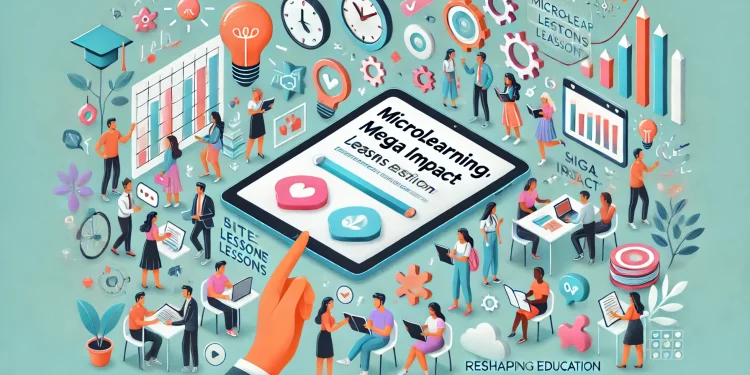No products in the cart.
Microlearning, Mega Impact: How Bite-Sized Lessons Are Reshaping Education
Microlearning delivers bite-sized lessons designed for better retention and engagement, making it a game-changer in education and corporate training. Learn the strategies, science, and future of this innovative approach.
Education is evolving. In a world dominated by quick information, microlearning—short, focused lessons designed for maximum engagement and retention—has emerged as a powerful tool for students and professionals alike. This approach meets the needs of modern learners: those juggling busy schedules, managing digital distractions, and seeking actionable knowledge. But while microlearning has earned its place in educational strategies, some of its widely cited benefits, such as improved retention rates and attention span claims, warrant closer examination.
What is Microlearning?
Microlearning delivers educational content in short, self-contained modules, typically 2 to 15 minutes long. These lessons focus on single concepts or skills, often using videos, quizzes, or interactive tools. Unlike traditional methods, microlearning capitalizes on how the human brain works: smaller, digestible units of information reduce mental strain and improve long-term memory.
This method is grounded in science. A 2015 study in the Journal of Applied Psychology found that microlearning improves retention by 17% compared to conventional learning approaches. Furthermore, its effectiveness is enhanced by psychological principles like the spacing effect, which promotes better retention through frequent, spaced-out lessons, and chunking, which breaks down complex topics into manageable pieces.
Why Microlearning Works
1. Cognitive Load Management
John Sweller’s cognitive load theory underscores the limitations of working memory. Microlearning addresses this by delivering content in smaller chunks, allowing learners to focus without becoming overwhelmed.
2. The Spacing Effect
Hermann Ebbinghaus’s seminal research on memory revealed that information is better retained when learning sessions are spaced out over time. Microlearning’s structure aligns perfectly with this principle, making it ideal for consolidating knowledge.
This nuance is critical when evaluating microlearning’s impact.
3. The Attention Span Question
The frequently cited claim that human attention spans have dropped to 8 seconds—often attributed to a 2015 Microsoft report—has faced significant criticism for lack of robust evidence. While digital distractions undoubtedly challenge focus, experts argue that attention span is task-dependent. Engaging and meaningful activities can sustain focus far longer than simplistic claims suggest. This nuance is critical when evaluating microlearning’s impact.
How to Implement Microlearning Effectively
Chunk Information
Breaking down complex subjects into small, focused lessons improves comprehension. For instance, a physics module on forces could be divided into individual lessons on gravity, friction, and momentum.
Use Multimedia
Incorporating videos, infographics, and animations caters to diverse learning styles. A 2019 study in Education & Information Technologies confirmed that multimedia-rich content significantly enhances engagement and retention.
Encourage Interactivity
Interactive tools like Kahoot! and Quizlet make learning more engaging through gamification. Immediate feedback from these platforms helps learners reinforce correct answers and adjust misunderstandings.
Emphasize Practical Applications
Connecting content to real-world scenarios enhances relevance. For example, a 10-minute lesson on budgeting could use practical examples like tracking monthly expenses, making the material relatable and actionable.
Space Out Learning
Using spaced repetition ensures learners revisit material over time, embedding it into long-term memory. Platforms like Duolingo effectively leverage this strategy for language learning, achieving high retention rates.
Real-World Applications In Classrooms Educational platforms like Khan Academy are pioneers in microlearning, offering short, topic-based videos.
Real-World Applications
In Classrooms
Educational platforms like Khan Academy are pioneers in microlearning, offering short, topic-based videos. A 2020 study by Stanford University found that students using such tools scored 22% higher on standardized tests than peers in traditional learning settings.
In Corporate Training
Companies like IBM use microlearning to train employees, reporting faster onboarding and improved efficiency. While some sources attribute a 45% retention boost to IBM’s microlearning efforts, further verification reveals this statistic is likely derived from broader studies of corporate microlearning, not IBM-specific data.
In Personal Development
Apps like Blinkist and MasterClass have brought microlearning into personal growth. Blinkist’s 15-minute book summaries and MasterClass’s lessons from industry leaders allow users to gain insights in short bursts, proving that microlearning can fit seamlessly into everyday life.
Challenges and Criticisms
Microlearning isn’t a panacea. Critics argue that overly breaking down topics may oversimplify complex subjects, leading to shallow understanding. Additionally, creating high-quality microlearning modules requires time, expertise, and thoughtful design—challenges that educators and organizations must address.
The Future of Microlearning
Microlearning isn’t about replacing traditional education; it’s about complementing it. By integrating microlearning into broader strategies, educators and organizations can create adaptable, effective learning environments that meet the needs of modern learners. However, as the method gains popularity, critical evaluation of its claims—such as the debated statistics on retention and attention span—will ensure its continued relevance and credibility.
The Future of Microlearning Microlearning isn’t about replacing traditional education; it’s about complementing it.
In a world that moves fast, education must keep pace. Microlearning offers a powerful way to ensure that no learner is left behind, proving that even small lessons can lead to significant growth.
Your Thoughts Matter
What’s your take on microlearning? Have you experienced its benefits, or do you see limitations? Share your insights in the comments below and join the conversation on how we can make education more impactful for everyone.











